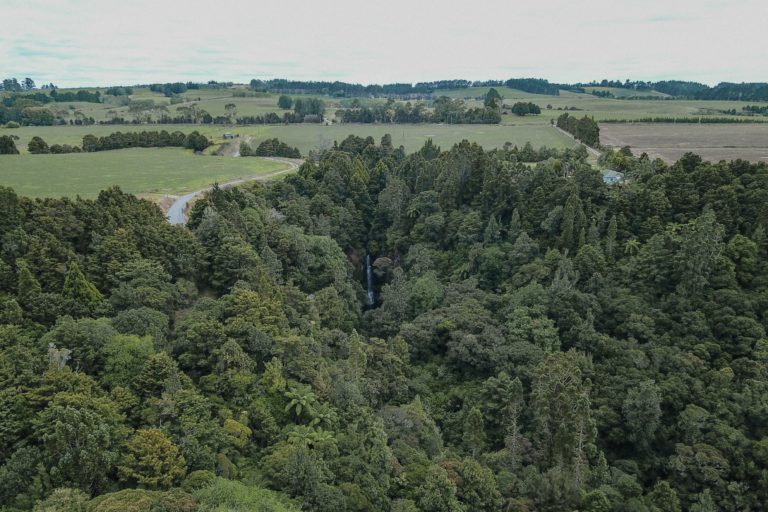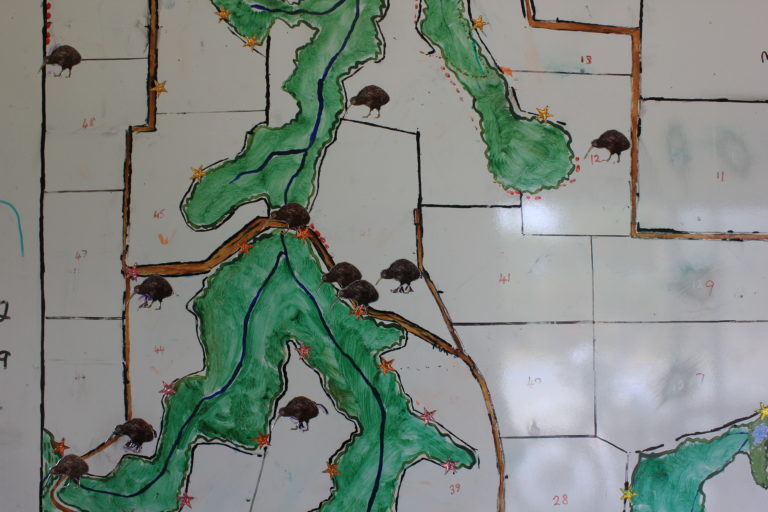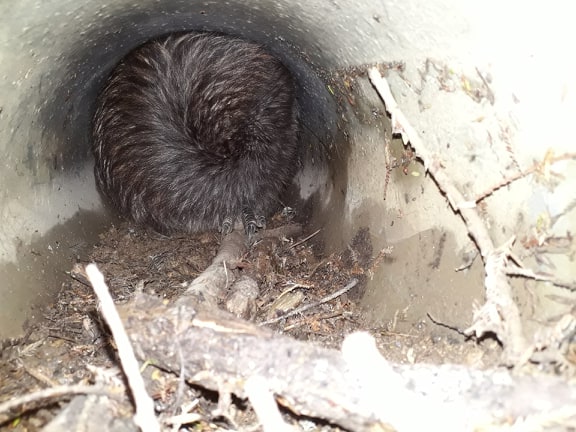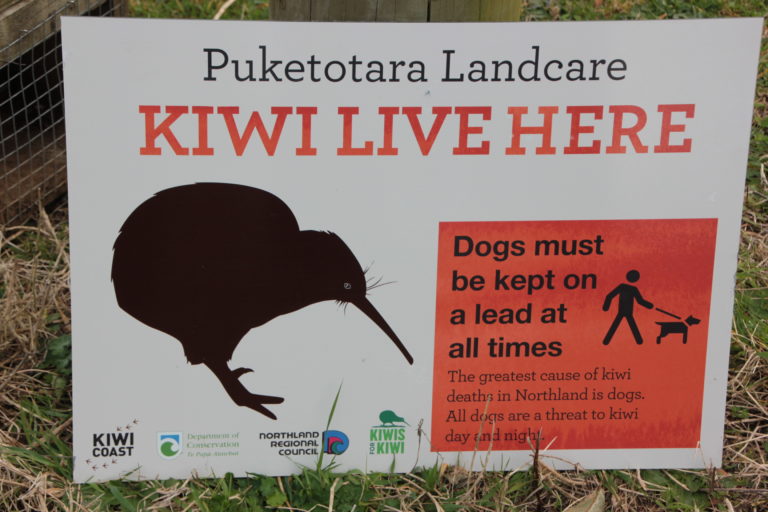Jane and Roger Hutchings haven’t had a dog on Lodore Farm, their 450-hectare Northland property, in over 20 years – but they do have a lot of North Island brown kiwi. “We estimate we have at least 50 pairs of North Island Brown kiwi,” Jane says. “We do the kiwi call census every year in two different areas of the farm. I’ve sat in the same spot for the last 8 years and Roger has another area he has counted in the last few years.”
This gives the Hutchings an idea of how many birds they have in certain areas. Calls identify male or female birds, a compass bearing and distance apart. The good news is counts are going up meaning young birds are surviving.
Jane’s call-count spot is a mixture of pasture and regenerating bush while Roger counts kiwi calls from an area of mature bush.

“There are big kauri and rimu there that have never been touched,” says Jane, “along with pockets where – 80 or 100 years ago – they chopped out big totara. There is still beautiful stands of huge totara with the odd stump from where past farmers took them out.”
Their bush area even has four beautiful waterfalls , each being very different. It’s an idyllic setting.
“We’re lucky,” says Jane. “We have to pinch ourselves sometimes. It’s a very pretty farm.”
The Hutchings farm in Okaihau, close to Kerikeri and have 700 Ayrshire dairy cows.
“Cows are creatures of habit,” says Jane. “We don’t need working dogs. With the drought over summer, we’ve been giving the cows some meal at the cowshed, so we just have to open the gate and they walk to the shed for their meal.”
Bringing the cows in is sometimes a chance for a bit of kiwi-spotting as well.

“We have a map up in the cowshed,” explains Jane, “If anyone sees a kiwi they put it on the map with the date. Roger’s lived here all his life – 56 years – and he reckons he’s seen about 20 kiwi in his lifetime. Ten of those have been in the last year. One day last year Roger was getting the cows in and he saw 3 kiwi in the paddock!”
Workers on the farm have become quite blasé about spotting kiwi too.
“Some of our workers were here for 2 or 3 years before they saw their first kiwi, but now they just mention casually ‘I saw a kiwi…’,” Jane says.
Predator traps are the main reason kiwi are doing well and being seen more often.
“We’ve got 30 or 40 double-ended stoat traps on the farm and some Steve Allan traps made by a guy in Kaitaia,” says Jane. “They’re good possum traps and also get rats and you can move them around easily.”
Jane and Roger have also been trialling AT220 traps which self-set after killing possums and rats.
“They’re really good. We had 5 dead possums in a week. Then the possum carcases were disturbed and we were worried we had a pig,” says Jane. “I set up a trail camera and was relieved to see it was a mum and dad weka and their two chicks eating the maggots.”
Until 10 years ago there were no weka on the farm at all.
“Now they’re everywhere,” says Jane. “We get them in the live catch cages sometimes and have to be careful with kill traps. Because of weka’s curiosity we have raised all our kill traps so as not to get them. We have to be very careful with everything and put things higher and steeper.”
As well as traps, the Hutchings have bait stations, but these days prefer to staple bait bags directly onto trees.
“When we first started, we used bait stations and they were ripped off the trees, as there were so many possums,” says Jane. “Now the bait in stations just goes mouldy. With bait bags we put 1 or 2 pellets in a bag and we can spread out and cover a lot of land.”
Roger and Jane also use a few live-catch cages.
“We caught 41 cats last year,” says Jane. “Only a few might have been dumped. Most were born and bred feral. Living near town there is a continual influx.”
Jane has also become a huge fan of trail cameras.
“We bought one out of interest and I was so excited when we got our first kiwi video,” she remembers. “We put the camera out where there was kiwi sign and we got a video that night. Now we’re disappointed if we don’t get kiwi on camera.”

The trail cameras help Roger and Jane get an idea of where kiwi are all over the farm.
“I’ve also learnt what kiwi poo smells like and how to spot kiwi sign such as probe holes from their beaks,” says Jane who got some help with kiwi-tracking from a Massey student who worked on the farm over summer.
“He was the son of a kiwi handler and he was like a kiwi dog himself,” says Jane. “He could smell kiwi in the bush and find their burrows.”
One kiwi pair that Jane caught on camera lived together in a burrow and would leave each evening within 5 minutes of each other.
“Each night the male would come out first and speed off into the bush for a feed while the female dawdled and poked around the burrow. Then 12 hours later the male would rush back first and go straight into the burrow, while the female dawdled back again.”
One night the Hutchings were out killing a wasp nest when a fern moved. On closer inspection there was a nice female bird in the fern.
“We knew a kiwi burrow must be near but it took us a week to find where it was. It was sleeping in a culvert, so we put a camera on the culvert and found there were two kiwi using it – one at each end,” says Jane. “One was curled up in a little ball – a spiral of feathers with its head hidden from sight.”
The culvert is an old one and not really in use. Jane thinks it will still be fine for the kiwi once Northland’s current drought ends. But just in case there are kiwi looking for a change of real estate, there are also several kiwi houses dotted around the farm.
“A landcare group in Russell made them,” says Jane. “We put them in a few spots but it was 2 or 3 years before a kiwi went in. One day I lifted a lid and there was a kiwi. One pair were using a kiwi box each night. We named them Harry and Meghan and hoped they might nest there, but they moved out before nesting which was disappointing.”
The pair may have nested nearby though.
“We have a video in the same area of a tiny 2-week old kiwi chick so hopefully it was theirs,” says Jane. “We also have another video of a big kiwi chasing a little kiwi around one of the kiwi houses. They are very territorial. And just this weekend I lifted a lid and found a kiwi that wasn’t one of the normal pair from that area. It’s a young bird and on video it comes out and puts fern in front of the hole just as if the nestbox was a burrow.”

“Kiwi don’t see the infra-red camera,” Jane explains. “So their behaviour is totally natural. Possums, weka and cats see the light come on the camera and come right up to it for a closer look.”
Jane often posts her kiwi videos on the Facebook page of her neighbourhood landcare group, Puketotara Landcare, to help keep people interested. She is also a trustee for Kiwi Coast.
“When new neighbours moved into a recent lifestyle subdivision we held a meeting to show them the traps and gave each household a couple of traps to get them started.”
About 4 or 5 neighbouring farmers make up the core membership of the Puketotara group with many other farming families happy to be members and support the work by paying someone to carry out pest control on their properties. Those core people include Ann and Steve Kearney who own a neighbouring dairy farm and Andrew Mentor who is the Mid North co-ordinator for Kiwi Coast.
“With these people we have created an inland island without a predator fence, but with a ring of traps, where we are seeing Kiwi breeding and moving out and spreading up the valley,” Jane says.

